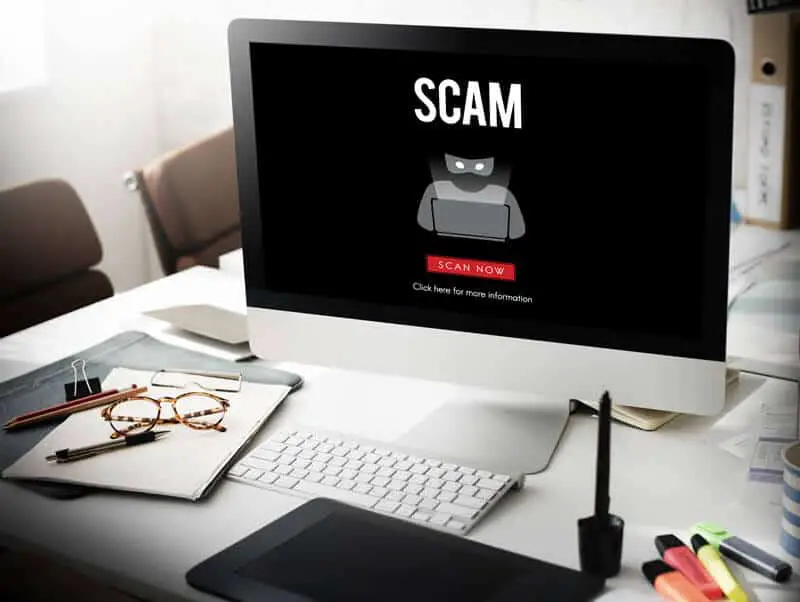Disclaimer: This post may contain affiliate links, meaning we get a small commission if you make a purchase through our links, at no cost to you. For more information, please visit our Disclaimer Page.
Most people who receive the notice that “Your System Is Heavily Damaged By (4) Virus’ are not, in fact, infected. It is a scam.
Table of Contents
The problem:
It’s easy to freak out when you hear the word ‘virus’. We are quick to protect our precious technology, and rightfully so.
We invest in hardware and software with little-to-no idea of what goes on behind the scenes. So when we’re told we have a virus — something wrong with our baby — it’s natural to panic.
Scam software preys on the idea that we don’t know what we’re doing. So let’s prove them wrong and learn how to fend for ourselves and our machines.
What is scam software?
Sometimes your software might really, truly have a virus. Other times, it’s a scam.
What is the purpose of this scam? Good question.
Unless you’ve been living under a rock, you know that most of our information is accessible online. Big companies trade on your trends and habits to inform their marketing and growth.
Why do we allow them to do this? They make the stuff we want.
So there’s an element of convenience, but more importantly, an element of trust. When an alert tells us there’s a virus, we believe that it’s our machine that needs to be protected; sometimes it’s us who needs the protection.
Scam virus alerts play on your sense of responsibility and — let’s face it — necessity that comes with your PC. Where legit software shares that same responsibility, scam software goes into your system to take your info.
Generally, it’s just annoying, but the worst case can lead to identity theft. The step between annoying and identity theft is pretty large and therefore it’s better to know how to deal with these things as quickly and efficiently as possible.
Related Reading: How to Disable Avast
What is The Four (4) Virus:
It’s an average evening and your scrolling through your phone before you nod off. You’ve dropped your phone on your face twice, which is one drop less than the night before so you’re feeling good. Suddenly, as you open your browser a pop up comes up!
‘Your system is heavily damaged by four (4) virus’.
You can’t click out of it. This is known as ‘tab locking’. The virus alert doesn’t allow you to get away, you’re trapped. You’re then redirected to their virus blocking software, which is entirely fake.
Note: if you are not looking for virus software, yet it finds you? 9.9/10 times you’ve got yourself a scam.
It then tells you that they can fix your problem for just a small fee. Remember, this is a problem that they’ve invented.
If you aren’t careful and pay this fee (and who could blame you — you’re just trying to protect your PC), some viruses can steal your financials and identity.
Note: we don’t want that.
What it looks like:
The full message the sneaky virus sends to your PC is as follows:
Your system is heavily damaged by (4) virus!
{DATE}
We have detected that your Windows 7 is 28.1% DAMAGED because of (4) harmful viruses from recent
adult sites,
If you do not remove the virus now, it will cause permanent damage to your system, corrupt your photos,
data, applications, etc.
Here’s what you NEED to do (step by step):
Step 1: Tap the button and install PC SmartCIeanup for free now!
Step 2: Open the app to fix your system now!
3 minutes and 0 seconds
REMOVE VIRUSES>>
It’s a very thorough message, giving you potential ‘causes’, ‘ramifications’, and ‘solutions’. Whoever wrote it really knows how to mess with us users hitting all the right (wrong?) buttons.
Macbooks will receive a mac specific message, and smartphones will receive an almost identical message with the exception that they will be asked to download an app first.
Even if the app says it is free, clicking on any of these links grants access to the software to track a number of information portals.
How to rid yourself of the dreaded Four (4) Virus
Simply dragging the files to trash is not the answer. When you do this, bits of the virus stays behind, just dragging everyone down.
What you need to do is uninstall, erasing every trace of the virus.
To uninstall with Windows 8,7, Vista, or XP, you’ll need to do the following:
- Hold the Windows Logo Button and “R” on your keyboard.
A Pop-up window will appear. - In the field type in “appwiz.cpl” and press ENTER.
A window with all the programs installed on the PC. - Select the program that you want to remove, and press “Uninstall”.
Don’t forget to backup your data before uninstalling anything just in case. We won’t want to be throwing out any babies with that nasty bathwater.
Mac users, this one’s for you, and a little extra to weed out the excess garbage:
- Hit the ⇧+⌘+U keys to open Utilities.
- Find Activity Monitor and double-click it.
- Check that there are no files that look suspicious (things you didn’t download or didn’t come with the device).
- Hit these guys again, ⇧+⌘+A, but this time select Applications.
- In the Applications menu, look for any suspicious app or even an app with the same name as the Four (4) Virus. If it’s there, hit “Move to Trash”.
- Go to Accounts, then select Login Items preference. You get a list of items that boot automatically when you log in. Look for more suspicious apps. If you find it, select the minus icon to deselect automatic boot.
Now you know!
A good rule of thumb is: don’t click while under pressure. Sure, most of us could take better care, and a lot of us are visiting adult sites, and those adult sites come with their share of viruses, but virus ware — the good ones — don’t threaten your time or money.


